Art paper offers a smooth texture ideal for detailed sketches, while watercolor paper features a thicker, textured surface designed to absorb water and prevent warping during painting. Choosing watercolor paper enhances pigment blending and durability for wet media, making it essential for vibrant, long-lasting watercolor artworks.
Table of Comparison
| Feature | Art Paper | Watercolor Paper |
|---|---|---|
| Material | Primarily wood pulp or cotton blend | 100% cotton or high-quality cellulose |
| Texture | Smooth or lightly textured | Rough or cold-pressed textured surface |
| Weight | 100-160 gsm (thin to medium) | 190-300+ gsm (heavy, durable) |
| Absorbency | Low absorbency, suited for dry media | High absorbency, ideal for wet media |
| Best For | Sketching, dry media, light washes | Watercolors, gouache, heavy washes |
| Durability | Less durable, prone to buckling | Highly durable, resists warping |
| Price | Generally affordable | Premium pricing due to quality |
Introduction: Understanding Art Paper vs Watercolor Paper
Art paper and watercolor paper differ primarily in texture, weight, and absorbency, which directly affect painting techniques and results. Watercolor paper is specifically designed with high absorbency and a textured surface to handle water-based media without warping or bleeding, typically weighing 140 lb (300 gsm) or more for durability. In contrast, general art paper varies widely in finish and thickness, often lacking the necessary qualities for watercolors but suitable for dry media like charcoal, pastels, or pencil sketches.
Key Differences Between Art Paper and Watercolor Paper
Art paper generally features a smooth surface suitable for dry media such as pencils and charcoal, while watercolor paper is specifically textured with a high cotton content to absorb and hold water-based paints effectively. Watercolor paper typically comes in cold-pressed, hot-pressed, and rough varieties, providing varying textures that enhance paint behavior and blending, whereas art paper usually lacks these specialized textures. The weight of watercolor paper is significantly higher, often around 300 gsm, compared to lighter art papers, ensuring durability and preventing warping during wet painting techniques.
Surface Texture: Smoothness and Tooth Comparison
Watercolor paper typically features a pronounced tooth, providing a textured surface that grips pigment and water, enhancing color absorption and blending effects ideal for watercolor techniques. Art paper surfaces vary from smooth to slightly textured, offering less tooth, which suits detailed work and media requiring finer control such as graphite or ink. Choosing between the two depends on the desired paint behavior and surface interaction, with watercolor paper excelling in fluid, layered washes and art paper favoring precision and sharp lines.
Paper Weight and Thickness: Durability and Support
Art paper typically ranges from 90 to 300 gsm, offering moderate thickness and durability suitable for pencil, ink, and light washes, whereas watercolor paper usually starts at 190 gsm and can exceed 600 gsm, providing superior thickness and resistance to warping during heavy water application. The heavier weight and dense texture of watercolor paper support repeated layering and vigorous brushwork, preventing buckling and ensuring longevity of the artwork. Consequently, artists seeking durability and optimal paint absorption favor heavier, thicker watercolor paper over lighter art paper for wet media techniques.
Absorbency: Handling Water and Paint on Different Papers
Watercolor paper is specially designed with high absorbency, allowing it to handle multiple washes of water and pigment without warping or bleeding, making it ideal for wet-on-wet techniques. Art paper, often smoother and less textured, absorbs less water, which can cause paint to sit on the surface and result in uneven drying or buckling when heavily saturated. Choosing watercolor paper enhances control over pigment flow and color blending due to its capacity to retain moisture evenly across the painting surface.
Suitability for Various Painting Techniques
Art paper offers a smooth surface ideal for detailed drawing and light washes, making it suitable for techniques like pencil, ink, and light acrylic applications. Watercolor paper has a textured, absorbent surface designed to handle heavy washes, wet-on-wet, and layering techniques typical in watercolor painting. Choosing the right paper depends on the medium and technique, with watercolor paper excelling in water-based painting and art paper better suited for dry or mixed media.
Color Vibrancy: How Paper Type Impacts Pigment
Watercolor paper's textured, porous surface enhances pigment absorption, resulting in vibrant, luminous colors that maintain intensity after drying. In contrast, standard art paper, often smoother and less absorbent, can cause pigments to sit on the surface, leading to duller colors and potential fading over time. Selecting watercolor paper significantly improves color vibrancy and pigment longevity in painting applications.
Cost and Availability of Art Paper vs Watercolor Paper
Art paper generally offers more affordable options compared to watercolor paper, making it suitable for artists on a budget. Watercolor paper, due to its specialized texture and cotton content, tends to be more expensive and less widely available in general art supply stores. While art paper can be found easily in various weights and finishes, watercolor paper is typically stocked in fewer sizes and higher price ranges, reflecting its tailored use for wet media.
Common Mistakes When Choosing Painting Paper
Many artists mistakenly select art paper instead of watercolor paper, overlooking the latter's superior absorption and textured surface essential for watercolor paints. Using art paper can cause colors to bleed, warp, or fail to blend properly due to its thinner and less durable composition. Opting for 100% cotton watercolor paper with proper weight (140 lb or higher) prevents common issues like buckling and uneven pigment distribution during painting.
Choosing the Right Paper for Your Painting Style
Art paper and watercolor paper differ significantly in texture, weight, and absorbency, influencing the final appearance of your painting. Watercolor paper, typically made of cotton with a higher gsm (usually 300gsm or above), offers better water absorption and durability, making it ideal for wet media and layered washes. For acrylic or mixed media artists, lighter art paper with less absorbency may be preferable for faster drying times and detailed brushwork.

Infographic: Art paper vs Watercolor paper for Painting
 azmater.com
azmater.com